2002 MERCEDES-BENZ G500 reset
[x] Cancel search: resetPage 63 of 385
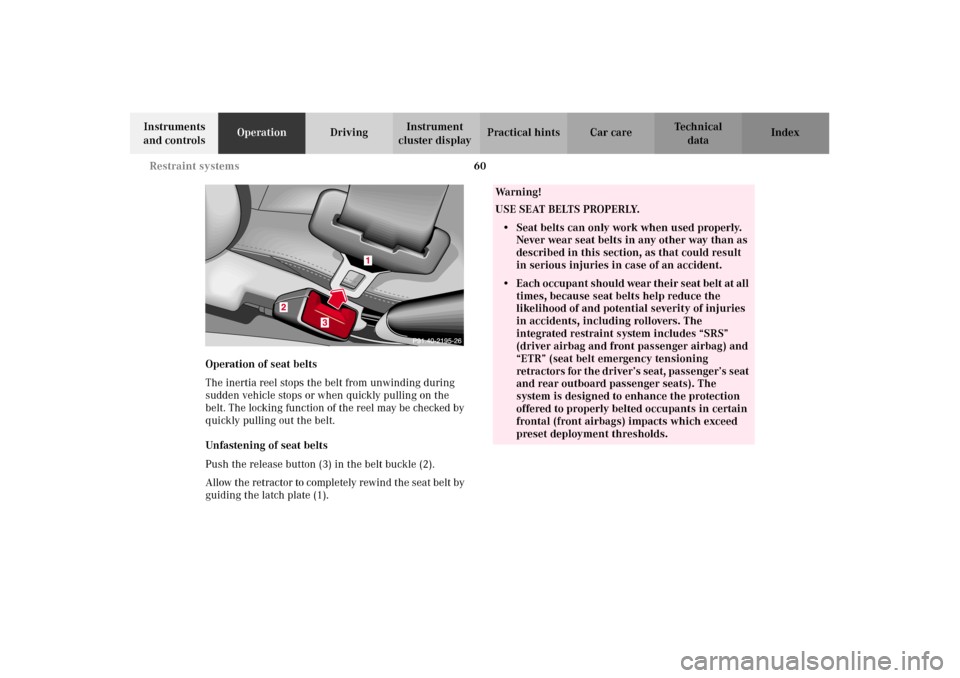
60 Restraint systems
Te ch n i c a l
data Instruments
and controlsOperationDrivingInstrument
cluster displayPractical hints Car care Index
Operation of seat belts
The inertia reel stops the belt from unwinding during
sudden vehicle stops or when quickly pulling on the
belt. The locking function of the reel may be checked by
quickly pulling out the belt.
Unfastening of seat belts
Push the release button (3) in the belt buckle (2).
Allow the retractor to completely rewind the seat belt by
guiding the latch plate (1).
Wa r n i n g !
USE SEAT BELTS PROPERLY.• Seat belts can only work when used properly.
Never wear seat belts in any other way than as
described in this section, as that could result
in serious injuries in case of an accident.• Each occupant should wear their seat belt at all
times, because seat belts help reduce the
likelihood of and potential severity of injuries
in accidents, including rollovers. The
integrated restraint system includes “SRS”
(driver airbag and front passenger airbag) and
“ETR” (seat belt emergency tensioning
retractors for the driver’s seat, passenger’s seat
and rear outboard passenger seats). The
system is designed to enhance the protection
offered to properly belted occupants in certain
frontal (front airbags) impacts which exceed
preset deployment thresholds.
J_G463.book Seite 60 Mittwoch, 19. September 2001 8:06 08
Page 67 of 385
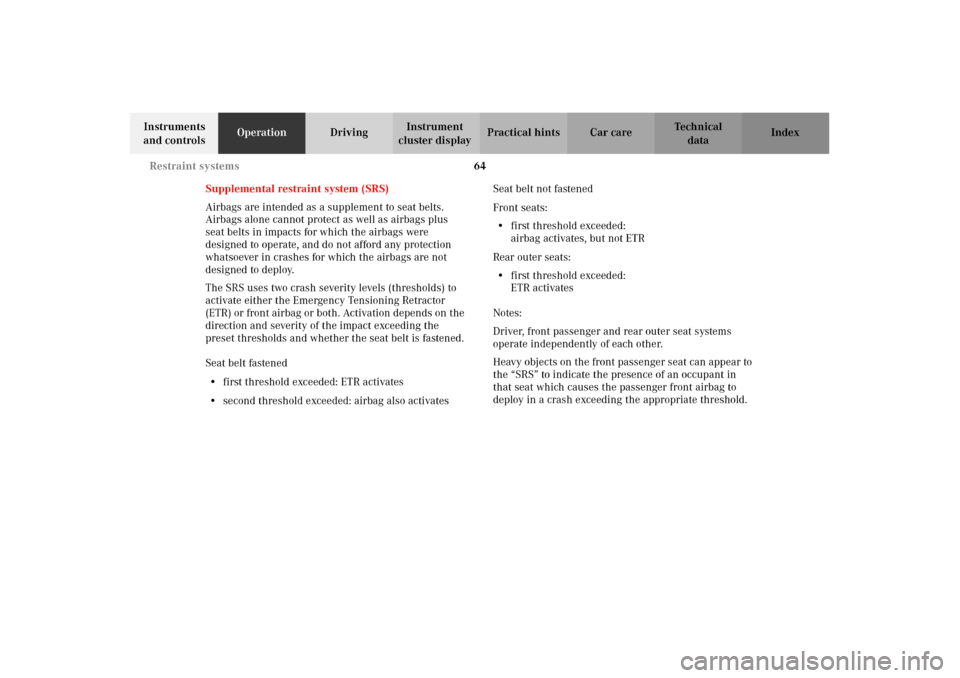
64 Restraint systems
Te ch n i c a l
data Instruments
and controlsOperationDrivingInstrument
cluster displayPractical hints Car care Index
Supplemental restraint system (SRS)
Airbags are intended as a supplement to seat belts.
Airbags alone cannot protect as well as airbags plus
seat belts in impacts for which the airbags were
designed to operate, and do not afford any protection
whatsoever in crashes for which the airbags are not
designed to deploy.
The SRS uses two crash severity levels (thresholds) to
activate either the Emergency Tensioning Retractor
(ETR) or front airbag or both. Activation depends on the
direction and severity of the impact exceeding the
preset thresholds and whether the seat belt is fastened.
Seat belt fastened
•first threshold exceeded: ETR activates
•second threshold exceeded: airbag also activatesSeat belt not fastened
Front seats:
•first threshold exceeded:
airbag activates, but not ETR
Rear outer seats:
•first threshold exceeded:
ETR activates
Notes:
Driver, front passenger and rear outer seat systems
operate independently of each other.
Heavy objects on the front passenger seat can appear to
the “SRS” to indicate the presence of an occupant in
that seat which causes the passenger front airbag to
deploy in a crash exceeding the appropriate threshold.
J_G463.book Seite 64 Mittwoch, 19. September 2001 8:06 08
Page 68 of 385

65 Restraint systems
Te ch n i c a l
data Instruments
and controlsOperationDrivingInstrument
cluster displayPractical hints Car care Index Emergency tensioning retractor (ETR)
The seat belts for the front seats and outboard
passenger seats are equipped with emergency
tensioning retractors. These tensioning retractors are
located in each seat belt buckle and become
operationally ready with the key in starter switch
position 1 or 2.
The emergency tensioning retractors are designed to
activate only when the seat belts are fastened during
frontal impacts exceeding the first threshold of the SRS
and in rear impacts exceeding a preset severity level.
They remove slack from the belts in such a way that the
seat belts fit more snugly against the body restricting its
forward movement as much as possible.
In cases of other frontal impacts, angled impacts, roll-
overs, certain side impacts, or other accidents without
sufficient frontal or rear impact forces, the emergency
tensioning retractors will not be activated. The driver
and passengers will then be protected by the fastened
seat belts and inertia reel in the usual manner.
For seat belt and emergency tensioning retractor see
page 71.Note:
The emergency tensioning retractors for the driver and
front passenger seats will only deploy if the front seat
belts are buckled.
The rear center automatic two point seat belt is not
equipped with an emergency tensioning retractor.
J_G463.book Seite 65 Mittwoch, 19. September 2001 8:06 08
Page 69 of 385
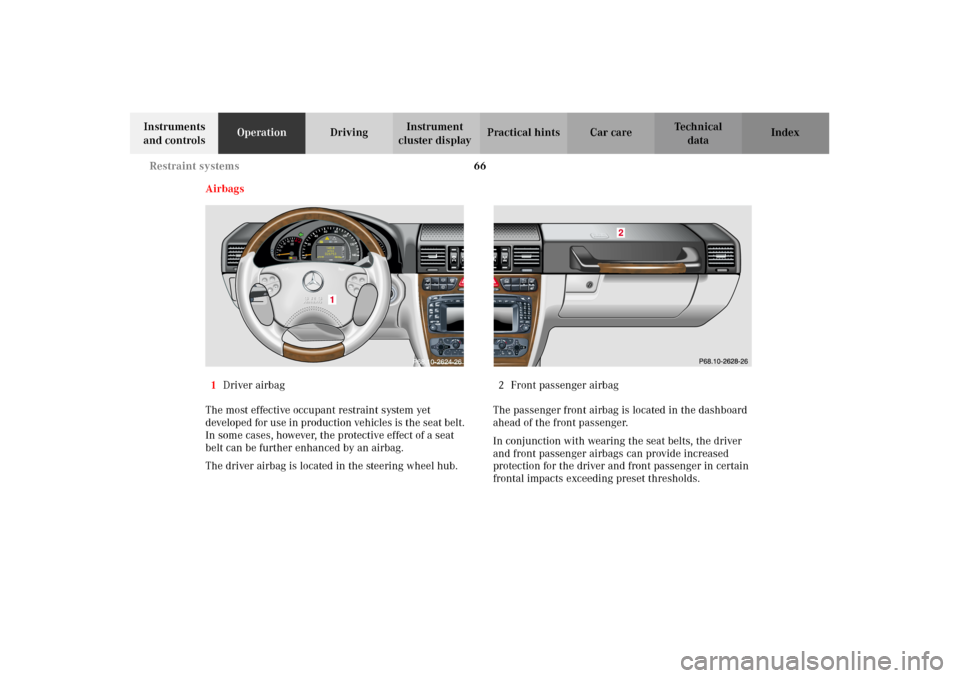
66 Restraint systems
Te ch n i c a l
data Instruments
and controlsOperationDrivingInstrument
cluster displayPractical hints Car care Index
Airbags
1Driver airbag
The most effective occupant restraint system yet
developed for use in production vehicles is the seat belt.
In some cases, however, the protective effect of a seat
belt can be further enhanced by an airbag.
The driver airbag is located in the steering wheel hub.2 Front passenger airbag
The passenger front airbag is located in the dashboard
ahead of the front passenger.
In conjunction with wearing the seat belts, the driver
and front passenger airbags can provide increased
protection for the driver and front passenger in certain
frontal impacts exceeding preset thresholds.
BACK
D
IS
P M
O
T
INFO
DEL
J_G463.book Seite 66 Mittwoch, 19. September 2001 8:06 08
Page 71 of 385

68 Restraint systems
Te ch n i c a l
data Instruments
and controlsOperationDrivingInstrument
cluster displayPractical hints Car care Index
Front airbags
The driver and front passenger front airbags are
designed to activate only in certain frontal impacts
exceeding a preset threshold.
The front passenger airbag deploys only if the front
passenger seat is occupied and the ü indicator lamp
in the instrument cluster is not illuminated, see
page 271.
Note:
Heavy objects on the front passenger seat can appear to
the “SRS” to indicate the presence of an occupant in
that seat which causes the passenger front airbag to
deploy in a crash exceeding the appropriate threshold.Important!
Airbags are designed to activate only in certain
frontal (front airbags) impacts which exceed preset
thresholds.
Only during these types of impacts, if of sufficient
severity to meet the deployment thresholds, will
they provide their supplemental protection.
The driver and passenger should always wear their
seat belts, otherwise it is not possible for the airbags
to provide their intended supplemental protection.
In cases of other frontal impacts, angled impacts,
roll-overs, other side impacts, rear collisions, or
other accidents in which the airbags are not
designed to deploy, the airbags will not be activated.
The driver and passenger will then be protected by
the fastened seat belts.
We caution you not to rely on the presence of the
airbags in order to avoid wearing your seat belt.
J_G463.book Seite 68 Mittwoch, 19. September 2001 8:06 08
Page 72 of 385
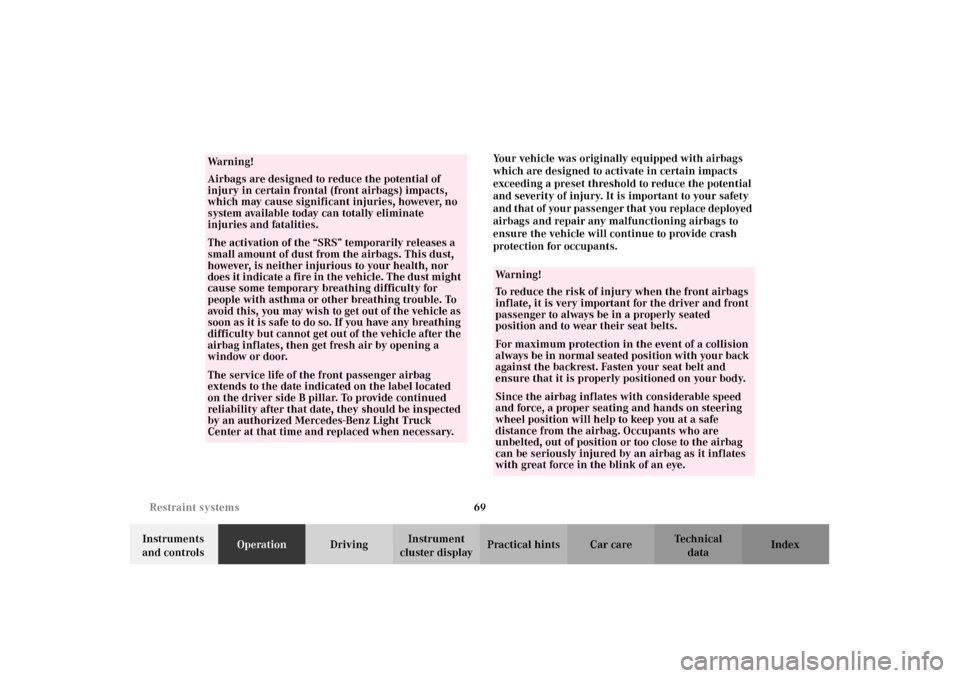
69 Restraint systems
Te ch n i c a l
data Instruments
and controlsOperationDrivingInstrument
cluster displayPractical hints Car care IndexYour vehicle was originally equipped with airbags
which are designed to activate in certain impacts
exceeding a preset threshold to reduce the potential
and severity of injury. It is important to your safety
and that of your passenger that you replace deployed
airbags and repair any malfunctioning airbags to
ensure the vehicle will continue to provide crash
protection for occupants.
Wa r n i n g !
Airbags are designed to reduce the potential of
injury in certain frontal (front airbags) impacts,
which may cause significant injuries, however, no
system available today can totally eliminate
injuries and fatalities.The activation of the “SRS” temporarily releases a
small amount of dust from the airbags. This dust,
however, is neither injurious to your health, nor
does it indicate a fire in the vehicle. The dust might
cause some temporary breathing difficulty for
people with asthma or other breathing trouble. To
avoid this, you may wish to get out of the vehicle as
soon as it is safe to do so. If you have any breathing
difficulty but cannot get out of the vehicle after the
airbag inflates, then get fresh air by opening a
window or door.The service life of the front passenger airbag
extends to the date indicated on the label located
on the driver side B pillar. To provide continued
reliability after that date, they should be inspected
by an authorized Mercedes-Benz Light Truck
Center at that time and replaced when necessary.
Wa r n i n g !
To reduce the risk of injury when the front airbags
inflate, it is very important for the driver and front
passenger to always be in a properly seated
position and to wear their seat belts.For maximum protection in the event of a collision
always be in normal seated position with your back
against the backrest. Fasten your seat belt and
ensure that it is properly positioned on your body.Since the airbag inflates with considerable speed
and force, a proper seating and hands on steering
wheel position will help to keep you at a safe
distance from the airbag. Occupants who are
unbelted, out of position or too close to the airbag
can be seriously injured by an airbag as it inflates
with great force in the blink of an eye.
J_G463.book Seite 69 Mittwoch, 19. September 2001 8:06 08
Page 88 of 385

85 Instrument cluster
Te ch n i c a l
data Instruments
and controlsOperationDrivingInstrument
cluster displayPractical hints Car care Index 1Knob for instrument cluster illumination,
seepage84
Reset knob for trip odometer, see page 88 and
individual settings, see page 108
2Tachometer
3Speedometer
4Left turn signal indicator lamp, see combination
switch on page 134
5Electronic stability program (ESP) warning lamp,
see page 270
6Right turn signal indicator lamp, see combination
switch on page 1347Multifunction display, see page 90
Malfunction and warning messages in the
multifunction display, see page 272
8Trip odometer, see page 88 and 94
9Main odometer, see page 94
10Display for transfer case program mode and gear
range indicators, page 210
11Malfunction/warning message memory,
seepage106
12Outside temperature indicator, see page 89
13Digital clock
To set the time, see individual settings on page 110
14Fuel gauge with reserve warning lamp, see page 268
J_G463.book Seite 85 Mittwoch, 19. September 2001 8:06 08
Page 91 of 385
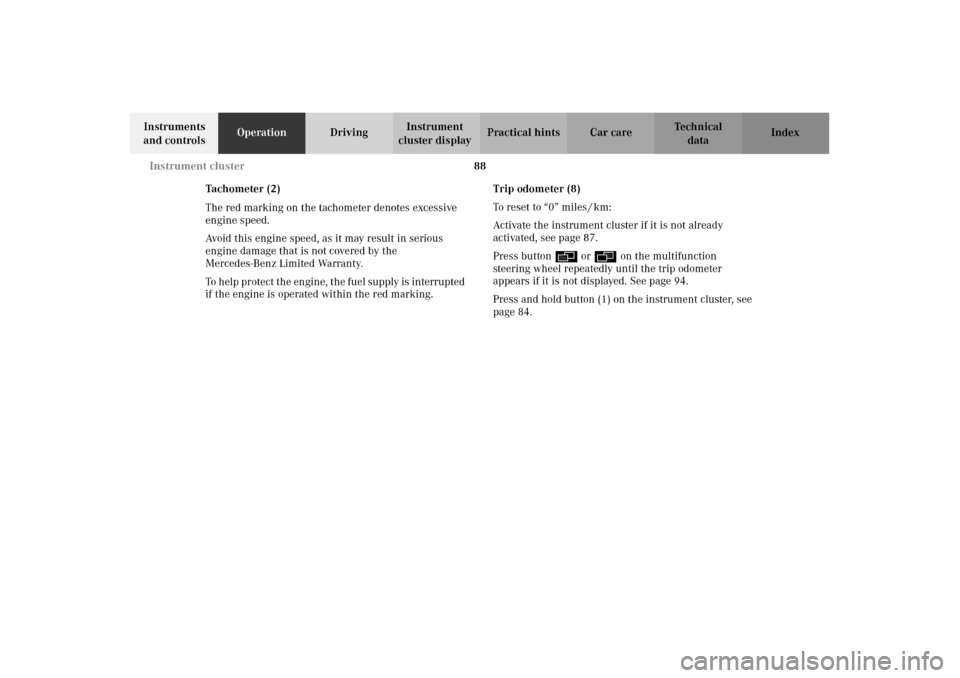
88 Instrument cluster
Te ch n i c a l
data Instruments
and controlsOperationDrivingInstrument
cluster displayPractical hints Car care Index
Tachometer (2)
The red marking on the tachometer denotes excessive
engine speed.
Avoid this engine speed, as it may result in serious
engine damage that is not covered by the
Mercedes-Benz Limited Warranty.
To help protect the engine, the fuel supply is interrupted
if the engine is operated within the red marking.Trip odometer (8)
To reset to “0” miles / km:
Activate the instrument cluster if it is not already
activated, see page 87.
Press button è or ÿ on the multifunction
steering wheel repeatedly until the trip odometer
appears if it is not displayed. See page 94.
Press and hold button (1) on the instrument cluster, see
page 84.
J_G463.book Seite 88 Mittwoch, 19. September 2001 8:06 08